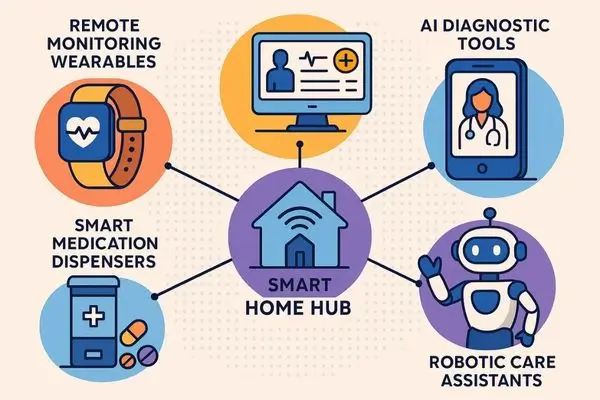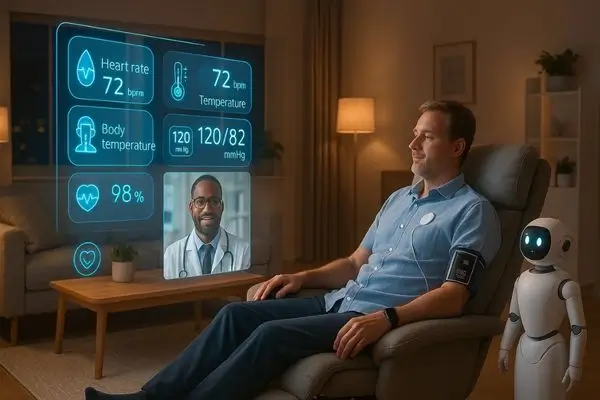In this post, hstech.io will dive deep ith you, into the world of health and home technologies. We’ll explore what they are, their game-changing benefits, the hottest trends shaping 2025, real-world examples, potential challenges, and a peek into the future.
Table of Contents
Table of Contents
Hey there, fellow tech enthusiasts and health buffs! Imagine starting your day with a gentle nudge from your smart bed, which has monitored your sleep patterns overnight and suggests a quick yoga session via your voice assistant.
Or picture your fridge scanning its contents and recommending a nutrient-packed smoothie based on your fitness goals. Sounds futuristic? Well, in 2025, health and home technologies are making this a reality.
These innovations blend smart home devices with cutting-edge health tools to create environments that not only make life easier but also prioritize your well-being.
Whether you’re a busy parent, a fitness fanatic, or someone caring for aging loved ones, these technologies could be your new best friend. Let’s get started!

What Are Health and Home Technologies?
The Basics of Integration
Health and home technologies refer to the seamless fusion of smart home devices with health-focused tools. Think IoT (Internet of Things) sensors in your living room that track air quality, or wearables synced to your home system for real-time health alerts. In 2025, this integration is powered by AI, making homes not just smarter but healthier.
Key Components
At the core are devices like smart thermostats that adjust for optimal sleep, air purifiers that combat allergens, and connected scales that log your progress. These work together via apps and cloud platforms, turning your home into a personal wellness hub.
Why It’s Booming Now?
With the rise of remote work and an aging population, demand for health and home technologies has skyrocketed. According to recent insights, advancements in AI and telehealth are driving this boom, making preventive care accessible from your couch.
The Benefits of Health and Home Technologies
Enhanced Daily Wellness
One major perk? Proactive health management. Smart home health devices can detect early signs of issues, like irregular heart rates via wearables, and notify you instantly. This means fewer doctor visits and more peace of mind.
Cost Savings and Efficiency
These technologies cut healthcare costs by enabling at-home monitoring. For instance, remote patient monitoring reduces hospital readmissions by up to 15% in some cases. Plus, energy-efficient devices like smart lights tied to your activity levels save on bills while promoting better habits.
Improved Accessibility for All
Especially for seniors or those with disabilities, health and home technologies foster independence. Voice-activated systems and fall-detection sensors ensure safety without constant supervision.
Benefits at a Glance
| Benefit | Description | Example Impact |
|---|---|---|
| Preventive Care | Early detection of health issues | Reduces emergency visits by 20% |
| Personalization | Tailored recommendations via AI | Boosts adherence to fitness goals |
| Sustainability | Eco-friendly monitoring | Lowers energy use in homes |
| Mental Health Support | Mood-tracking features | Improves overall well-being |
Popular Health and Home Technologies
1. Wearables and IoMT Devices
Wearable health devices like smart rings and fitness trackers are huge. In 2025, they’re evolving with AI to predict health events, such as stress spikes, and integrate with home systems for automated responses, like dimming lights to help you unwind.
2. Smart Home Ecosystems for Health
Think Google Home or Amazon Echo hubs that control everything from air quality monitors to medication dispensers. These smart home health devices use machine learning to learn your routines and suggest improvements, like reminding you to hydrate based on humidity levels.
3. Telehealth and Virtual Care at Home
Telehealth has exploded, with AI-powered diagnostics allowing virtual doctor visits from your living room. Combined with home tech, it creates “digital twins” virtual models of your health for personalized care.
Future Trends in Health and Home Technologies
4. AI and Predictive Analytics
By 2025, AI will dominate, with systems predicting diseases using home data. Imagine your mirror analyzing your skin for early signs of issues.
5. Expansion of Telehealth
Acute care-at-home programs are set to grow, blending health and home technologies for hospital-level care without leaving the bed.
Sustainable and Eco-Friendly Innovations
Green tech like nanosensors for precise health monitoring will reduce waste, aligning with global sustainability goals.
Global Connectivity with 6G
Looking ahead, 6G could supercharge these systems, enabling holographic doctor visits right in your home.
For more on AI’s role, check our post on AI in Healthcare. Or explore Smart Home Technology.
Real-World Examples
In Cyprus, elderly care tech includes telehealth and smart home devices for aging populations. Globally, systems like Nest thermostats paired with health apps adjust environments for better sleep, while Philips Hue lights sync with mood trackers for mental health support.

Challenges in Adopting Health and Home Technologies
Privacy and Security Concerns
With great data comes great responsibility. Hacking risks in connected devices are real, so robust encryption and regulations like GDPR are crucial.
Accessibility and Cost Barriers
Not everyone can afford these gadgets. In 2025, efforts are underway to make health and home technologies more inclusive, but upfront costs remain a hurdle for some.
Integration Issues
Mixing brands can be tricky your Apple HomeKit might not play nice with Samsung SmartThings. Standardization is key to smoother experiences.
Common Challenges and Solutions
| Challenge | Potential Solution |
|---|---|
| Data Privacy | Advanced encryption and user controls |
| High Costs | Subsidies and affordable alternatives |
| Tech Overload | User-friendly interfaces |
| Reliability | Regular updates and backups |
Why You Should Embrace Health and Home Technologies?
Picture this: You’re recovering from surgery, and your home adjusts lighting, temperature, and even plays calming music based on your vitals. That’s the power of these technologies they make health feel effortless and integrated into daily life.
As someone who’s tried a few (like a smart scale that syncs with my fridge app), I can say they add real value. But start small maybe with a basic wearable and build from there.
For deeper dives, visit authoritative sources like Philips Healthcare Trends or Medtronic Insights.
Wrapping It Up: Your Path to a Healthier Home
Health and home technologies in 2025 are more than gadgets they’re lifelines to better living. From AI-driven wearables to smart ecosystems, they’re empowering us to take charge of our wellness at home.
We’ve covered the basics, benefits, trends, and even the hurdles, showing how these innovations are reshaping our world.
Ready to upgrade your space? Start exploring devices that fit your needs, and share your experiences in the comments below. What health and home technologies are you most excited about?
Drop a note, and let’s chat! For more tech insights, browse our site at hstech.io. Let’s build healthier homes together!
Pingback: Cryptography and security: Its Working, 3 Types and best features Explained